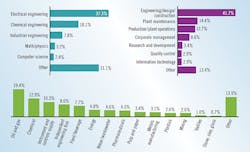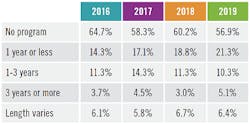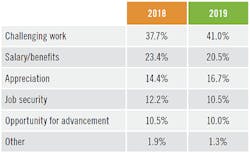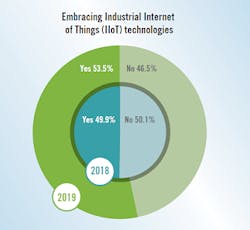The young get richer—amazingly and maybe logically. Following three straight years of declines in average age and two years of decreased average salaries, the more than 500 respondents to Control's annual salary survey reported their 2019 average pay actually increased by 2.2% from $91,460 last year to $93,517 this year, even though their average age continued to fall from 47.1 years to 45.6 years during the same period.
At first glance, this result can seem counter-intuitive because the younger, less-experienced personnel now entering the process industries typically earn far less than their older, more-experienced counterparts. These veterans are, of course, retiring in accelerating numbers, which often depletes the institutional expertise and tribal knowledge their applications and organizations need to run optimally and handle unusual situations. However, even though youth and smaller salaries should go hand in hand, the unexpected 2019 pay hike likely shows that retirement-driven brain drains are finally driving employers to compete more intensely by offering higher salaries to secure replacement engineers, technicians and operators. Likewise, this year's group also reports higher percentages than 2018 of those receiving four weeks of vacation or more, experiencing less worries about job security, and earning four-year college degrees or higher, though slightly more aren't paid for overtime (Figure 1).
Figure 1: After two years of overall decreases in pay, respondents to Control's 2019 salary survey reported a 2.2% increase in average salary this year, even though their average age continued to decrease for the third straight year. Likewise, the percentage receiving four weeks or more vacation jumped significantly, even as slightly more are working unpaid overtime. Meanwhile, women respondents dipped to 7.4% after two years of increases.
On the other hand, respondents receiving raises of as much as $4,000 or bonuses remained flat in 2019 as they did for the two years prior (Figure 2). Meanwhile, traditional benefits in all categories in 2019 continued to slide by one to four percentage points, as they've done for the past three years (Figure 3). This is a likely remnant of the formerly dominant trend that veteran personnel had more benefits than their rookie counterparts, even though impact of those packages is shrinking as older staffers continue to retire.
Another slightly disappointing shift is that, after two years of gains, the percentage of female respondents in the 2019 salary survey dipped to 7.4% from 9.1% last year and 8% in 2017. This decline is likely due to the different pools of respondents answering the salary survey each year, which can produce ups and downs in this and other categories. However, if a trend is developing, it will probably take another year or two to emerge in the survey.
Fighting for talent
Figure 2: Both the percentage of pay raises up to $4,000 and bonuses appear to have remained steady over the past two years. Before that, raises declined slightly, while bonuses increased.
Figure 3: For the third straight year, benefits in the top six categories were reduced. This could be because veteran staffers built up more benefits than their rookie counterparts, and the presence of those packages is shrinking as older personnel retire.
Recent age and salary shift aside, one situation that's been clear to everyone in the process industries for years is how hard it is to find and retain expert personnel.
"We have 33 total staff who average about 40 years old, but we've lost several hourly and salaried employees in the last three years, not so much to retirements, but more to do with pursuing different career paths," says Ron Cash, combined cycle technician at Lawrenceburg Power's 1,096-megawatt, combined-cycle power plant in Lawrenceburg, Ind., which is owned by the Lightstone Group LLC, a joint venture of Blackstone and ArcLight Capital Partners. "We also just found a person for one job, but it was very hard to fill because it required both mechanical engineering and electrical engineering skills. We considered approximately 40 candidates over two years, and eventually filled the position with an individual in his mid-30s. However, even then, he's an electrical engineer, and still needs some training on the mechanical side. We recruited on the company website, at Indeed.com, and even used headhunters, but none worked for us. We eventually heard from a vendor that another utility was cutting some positions, and that helped us find an experienced person because we needed someone that already had some years of service."
In general, Cash reports there are many maintenance engineering jobs in the utilities, but depending on the local market, they're often persistently hard to fill due to insufficient compensation. "Our positions pay more than similar manufacturing jobs in the Cincinnati area near us, but it's still not enough," he explains. "You can't offer to start engineers at just $60,000 and expect to fill jobs."
In addition, just as job applicants need more comprehensive skills, Cash adds his three-person maintenance staff also face technical challenges, such as calibrating transmitters, rebuilding and calibrating valves and actuators, rebuilding pumps, shaft alignment, general fabrication and programming software, and must learn to address new tasks if they don't know how already. "We know how to build and edit logic for Emerson Ovation software and our GE Mark 6E that runs the plant. Our company is good about getting us the training we need that can’t be acquired on our own. For instance, I'll be taking Ovation classes soon to get certified," says Cash. "We build relations with all our vendors, and they're usually willing to bend over backwards to help give us the tips we need. We also have a Sure Service agreement with Emerson that helps as well."
Constant variety fuels industry
Because process control and automation lies at the crossroads of many disciplines and industries, its practitioners come from many educational backgrounds and work experiences, and are employed in applications that have at least as many unique aspects. This variety of profiles are the bedrock underlying each year's salary survey, and they've remained remarkably constant from year to year, despite the topical differences they exhibit at first (Figure 4).
Figure 4: As usual, process operators, technicians and engineers possess educations and experiences that are as widely varied as the applications, businesses and industries in which they work.
As usual, more than 37% of 2019's respondents studied electrical engineering in college, which was closely followed by the more than 18% that studied chemical engineering. Curiously, even though information technology (IT) is rapidly emerging in the operations technology (OT) space, only 2.4% of this year's respondents reported studying computer science, though perhaps that level will increase later.
Once graduated and mixed in with process industry workforces, close to 42% of respondents agreed their job description was "engineering, design and construction," while more than 14% are in "plant maintenance," and close to 13% perform "production and plant operations." Also as usual, the industries they serve are even more varied. Oil and gas (19.4%) and chemical (12.9%) are still the traditional leaders, but strong single-digit representation continues for most process industries from food and beverage (7.7%) down to textiles (1.0%)
Social overtakes ads
Beyond this year's age and salary and shifts, another significant milestone was that more employers used social media for recruiting than print or online advertising. For the first time, just over half of 2019's respondents (50.4%) reported using LinkedIn, Facebook or other social media to recruit prospective employees, which was up from 44.9% in 2018. At the same time, just over 45% reported using print or online advertising, which was a slight drop from the more than 46% using advertising the year before (Figure 5).
Figure 5: Process industry managers and their companies employ many strategies to find, recruit, hire, nurture and retain new personnel, such as interacting with local organizations and communities, and joining and/or sponsoring science, technology, engineering and math (STEM) programs such as FIRST Robotics. For the first time, more employers used social media for recruiting than print or online advertising.
In-person visits to colleges and schools dropped one percentage-point from 37% to 36%, but all other strategies for finding and nurturing the next generation of process control personnel increased by about one percentage point or more. Meanwhile, the big winner was participating in or coaching local science, technology, engineering and math (STEM) teams and programs, which increased to 17.3% in 2019 from 12.7% the year before.
Investing in the future
Likewise, the reason even a slight bump up in 2019's average salary is such a big deal in the face of declining average age is it demonstrates that employers are investing in their new people and their future, which has unfortunately and too-often been rare in the past.
"In our industry, average ages are down because of all the recent retirements and because we've been dealing with such a large age gap," says Dean Hammond, business development manager for life sciences at ABB Inc.'s Americas-based industrial automation and energy division. "The process industry has many people 50 years old and up and many others 30 years old and younger, which is due to all the hiring freezes, mergers and acquisitions in the 1990s through to 2005. There was a lot of consolidation then, which often meant no one was hiring, and this continued through the 2008 recession."
Figure 6: Beyond recruiting and development, apprenticeship programs are on the rise with one-year and three-year-or-more programs increasing, and one-to-three-year programs decreasing.
Hammond reports average salaries are up because so many soon-to-retire veterans are already at high earning levels, while competition for skilled, younger staff is getting fierce, too. "Many young people are moving around to different companies, so employers have to offer higher salaries and better benefits to attract and retain them. Also, because so many students are graduating with such high debts, I think in the near future, we're going to see more companies in the process industries use matching student loan repayment benefits similar to 401k matching funds as a tool to differentiate themselves and recruit new employees."
Development and retention
Just as recruiting is on the upswing, 2019's respondents add that in-house apprenticeships and training programs are also making gains. Apprenticeships of one year or less are presently offered by more than 21% of their companies, which represents a steady increase over the 14% that offered them in 2016. At the same time, those with no apprenticeships decreased to almost 57% this year from almost 65% in 2016 (Figure 6).
Similarly, for the past two years, about 80% of respondents report they're happy with their existing skills and knowledge, while 81% report they're satisfied with the training offered by their companies (Figure 7). Primary sources of training have also remained largely consistent with 34.5% using self study and about 24.5% relying on their employers in 2018-19. However, on-the-job training increased to almost 17% this year from 15% last year.
When training isn't supported, the reasons why are usually divided evenly among lacks of time, money and management during the past two years. However, lack of time dropped to 28% in 2019 from 35% in 2018.
Figure 7: More than 80% of companies support skills training, which comes from a variety of sources, led by self study and employers. Firms that don't support training cite lacking time, money and management in equal proportions.
Challenges beat pay again
Figure 8: As usual, challenging work continues to be the most important ingredient in job satisfaction for respondents to Control's salary survey, but this year it and overall appreciation also posted significant gains over 2018, while salary and benefits experienced a similar decline in importance during the same period.
While recruiting and professional development programs are crucial, they're aided by the most rock-solid and commendable trend in Control's salary survey, which every year shows that respondents value challenging work above salary and benefits.
Plus, this trend appears to be increasing because 41% reported that challenging work was most important this year, which was up from close to 38% last year. Similarly, close to 17% said appreciation was most important this year, up from 14% in 2018.
Meanwhile, just over 20% reported salary and benefits were most important this year, which was down from 23% last year. Likewise, 10% said job security was most important this year, down from 12% in 2018. All of these results may further reflect increased opportunities and an improving job market for employees across the process industries.
IIoT and digitalization keep on rolling
Finally, one other well-known trend identified by 2019's salary survey is the ongoing emergence of the Industrial Internet of Things (IIoT) in the form of Internet protocols (IP) using Ethernet networks to communicate among devices, and access cloud-computing and other enterprise-level services.
Also passing the halfway mark for the first time, more than 53% of this year's respondents report they and their companies are embracing IIoT, while 49.9% were doing it last year. Likewise, just over half were not embracing IIoT last year, while only 46% aren't doing it this year (Figure 9).
Figure 9: the Industrial Internet of Things (IIoT) continues to make steady gains among process control and automation users and applications, which are increasingly adopting Ethernet networking, internet protocol (IP) communications, cloud-based computing and other IIoT technologies.
To help production and corporate teams keep pace with IIoT and other forms of digitalization, ABB's Hammond reports there are more software tools than ever for improving workloads and assisting colleagues and clients.
"I cringe at the 'do more with less' talk because it’s not about doing more, it’s about identifying what’s not working, stopping it, and working more efficiently using digitalization tools like Sales Force and electronic assistants. Sales forces are smaller now, so each person has to bring in higher volumes," explains ABB's Hammond. "Plus, everyone wants more time to interact with their customers, and tools like Salesforce, Skype, SharePoint and Google Classroom can help by reducing coordination time and increasing interaction time. Many of these tools have been available for years, but it's only in the past few years that they've been widely deployed, so enough people can use them to readily to collaborate and do more of the things that have a significant impact.
"For instance, video conferencing used to require finding a conference room and using technology that people weren’t proficient with. You also needed to concern yourself with what technology the people on the other end had in place, but now we can do it in 30 seconds on a laptop, and we just assume that the recipient has the necessary technology in place on their end. Process control engineers are gaining the same advantages because they can now access systems remotely in real time. Previously, the technology was available, but the backbone wasn’t always there to support it, so it often didn’t work. Now, the backbone is there to support these technologies, or it's available often enough that it's no longer a novelty. This lets me store information in the cloud, and use software like OneNote to access it from many devices like PCs, iPhones, iPads, etc. Software on the devices can then tie in to OneDrive in the cloud, which provides immediate context for notes, sharing with others, and access via any device. Years ago, software was an enabler to help sell hardware; then it transitioned to selling and licensing just the software; and now its moving to software as a service (SaaS) that just sells subscriptions.
"Eventually, even process controls will be sold as subscriber-based services. Training is already getting more virtual; users are recording operations they can watch anytime; and maintenance routines displayed on Google Glass for walkthroughs are coming, too. This means staff that usually only get a couple days training every year can now get training whenever needed."















